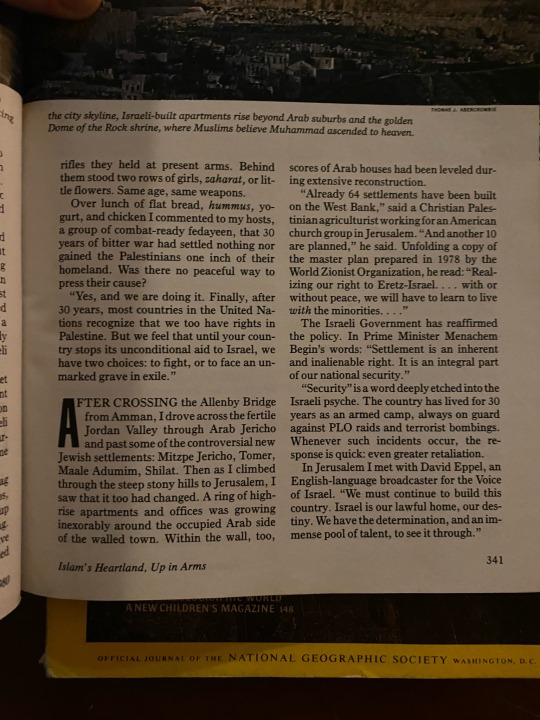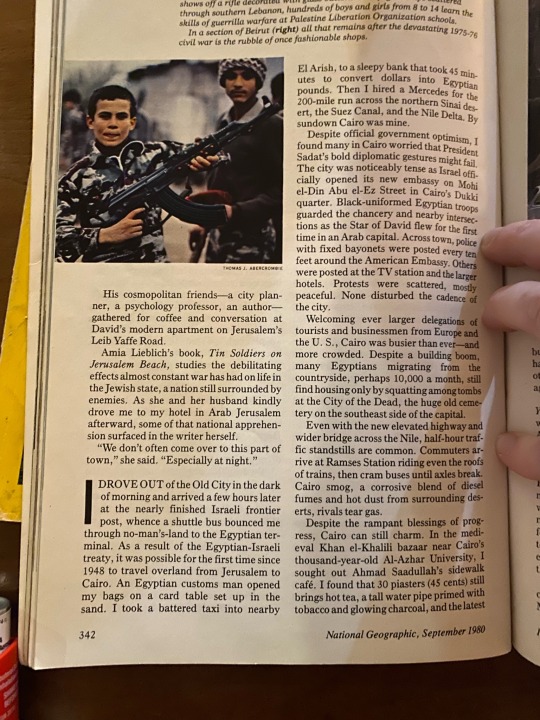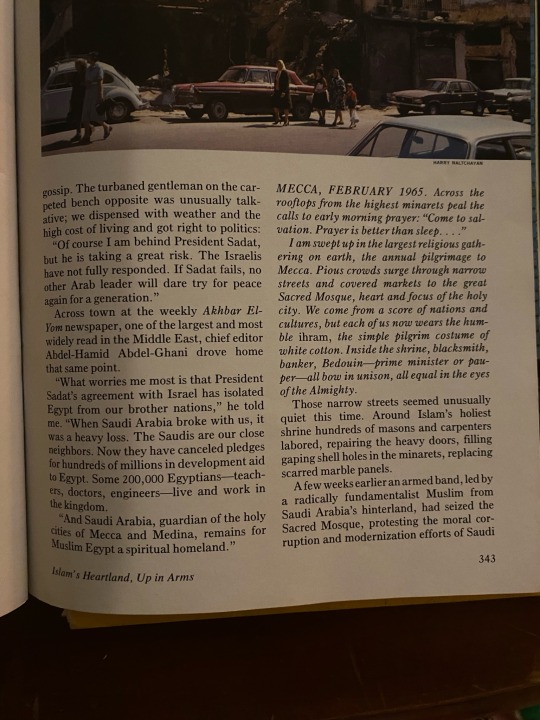#september 1980
Explore tagged Tumblr posts
Text

190 notes
·
View notes
Text
Hey check this out
I was making a zine (solarpunk ofc) and decided to use a bunch of old National Geographic magazines to cut up and use in a scrappy diy scrapbook fashion and of course I started reading them. This one in particular:

It caught my eye because it’s from September 1980 & talks about the Middle East. My brain wonders if they mention Palestine and they do! I copied the text for accessibility, but I put pictures at the end of the original pages.
“Jerusalem: reunited or occupied? The question has divided the city's 400,000 Jews and 100,000 Arabs since Israel annexed East Jerusalem in 1967.
BEIRUT, JANUARY 1975. Armed soldiers lead me through labyrinthine back streets, up a dark stairway to a midnight rendez-vous. Only a bare bulb lights the temporary command post; Yasir Arafat, chairman of the Palestine Liberation Organization, seldom dares spend two days in the same place. “Our argument is not with the Jews” He tells me. "We are both Semites. They have lived with us for centuries. Our enemies are the Zionist colonizers and their backers who insist Palestine belongs to them exclusively.
We Arabs claim deep roots there too."
Two decades ago Palestinians were to be found in United Nations Relief Agency camps at places like Gaza and Jericho, in a forlorn and pitiable state. While Palestinian spokesmen pressed their case in world cap-itals, the loudest voice the world heard was that of terrorists, with whom the word Palestinian came to be associated. Jordan fought a war to curb them. The disintegration of Lebanon was due in part to the thousands of refugees within its borders.
Prospects for peace brightened, however, when President Anwar Sadat of Egypt, most powerful of the Arab countries, made his historic trip to Israel in November 1977. A year later Sadat and Israeli Prime Minister Menachem Begin signed the Camp David accords, a framework for the return of the occupied Sinai Peninsula to Egypt.
The former enemies established diplomatic relations and opened mail, telephone, and airline communications.
The Camp David accords also addressed the all-important Palestinian question but left it vague. Sadat insists that any lasting peace depends on an eventual Palestinian homeland in the Israeli-occupied West Bank and Gaza. Israel agrees to limited autonomy for those regions, but, fearful of a new and hostile Palestinian state suddenly planted on its borders, insists that Israeli troops must maintain security there.
Crowded Rashidiyah refugee camp, set among orange groves south of the ancient Phoenician port of Tyre in Lebanon, lies on the front lines. Frequent pounding by Israeli military jets and warships seeking PLO targets has war-hardened its population, some 13,700 Palestinians.
At the schoolyard I watched a solemn flag raising. Uniformed ashbal, or lion cubs, stood rigid as color guards briskly ran up the green-white-and-black Palestinian flag.
Ranging in age from 8 to 12, they might have been Cub Scouts— except for the loaded rifles they held at present arms. Behind them stood two rows of girls, zaharat, or little flowers. Same age, same weapons.
Over lunch of flat bread, hummus, yo-gurt, and chicken I commented to my hosts, a group of combat-ready fedayeen, that 30 years of bitter war had settled nothing nor gained the Palestinians one inch of their homeland. Was there no peaceful way to press their cause?
"Yes, and we are doing it. Finally, after 30 years, most countries in the United Nations recognize that we too have rights in Palestine. But we feel that until your country stops its unconditional aid to Israel, we have two choices: to fight, or to face an unmarked grave in exile."
AFTER CROSSING the Allenby Bridge from Amman, I drove across the fertile Jordan Valley through Arab Jericho and past some of the controversial new Jewish settlements: Mitzpe Jericho, Tomer, Maale Adumim, Shilat. Then as I climbed through the steep stony hills to Jerusalem, I saw that it too had changed. A ring of high-rise apartments and offices was growing inexorably around the occupied Arab side of the walled town. Within the wall, too, scores of Arab houses had been leveled during extensive reconstruction.
"Already 64 settlements have been built on the West Bank," said a Christian Palestinian agriculturist working for an American church group in Jerusalem. "And another 10 are planned," he said. Unfolding a copy of the master plan prepared in 1978 by the World Zionist Organization, he read: "Real-izing our right to Eretz-Israel... with or without peace, we will have to learn to live with the minorities...
The Israeli Government has reaffirmed the policy. In Prime Minister Menachem Begin's words: "Settlement is an inherent and inalienable right. It is an integral part of our national security."
"Security" is a word deeply etched into the Israeli psyche. The country has lived for 30 years as an armed camp, always on guard against PLO raids and terrorist bombings.
Whenever such incidents occur, the response is quick: even greater retaliation.
In Jerusalem I met with David Eppel, an English-language broadcaster for the Voice of Israel. "We must continue to build this country. Israel is our lawful home, our des-tiny. We have the determination, and an immense pool of talent, to see it through." His cosmopolitan friends a city plan-ner, a psychology professor, an author gathered for coffee and conversation at David's modern apartment on Jerusalem's Leib Yaffe Road.
Amia Lieblich's book, Tin Soldiers on Jerusalem Beach, studies the debilitating effects almost constant war has had on life in the Jewish state, a nation still surrounded by enemies. As she and her husband kindly drove me to my hotel in Arab Jerusalem afterward, some of that national apprehension surfaced in the writer herself.
"We don't often come over to this part of town," she said. "Especially at night."
I DROVE OUT of the Old City in the dark of morning and arrived a few hours later at the nearly finished Israeli frontier post, whence a shuttle bus bounced me through no-man's-land to the Egyptian ter-minal. As a result of the Egyptian-Israeli treaty, it was possible for the first time since 1948 to travel overland from Jerusalem to Cairo. An Egyptian customs man opened my bags on a card table set up in the sand. I took a battered taxi into nearby El Arish, to a sleepy bank that took 45 minutes to convert dollars into Egyptian pounds, Then 1 hired a Mercedes for the
200-mile run across the northern Sinai des-ert, the Suez Canal, and the Nile Delta. By sundown Cairo was mine.
Despite official government optimism, I found many in Cairo worried that President Sadat's bold diplomatic gestures might fail.
The city was noticeably tense as Israel officially opened its new embassy on Mohi el-Din Abu el-Ez Street in Cairo's Dukki quarter. Black-uniformed Egyptian troops guarded the chancery and nearby intersections as the Star of David flew for the first time in an Arab capital. Across town, police with fixed bayonets were posted every ten feet around the American Embassy. Others were posted at the TV station and the larger hotels. Protests were scattered, mostly peaceful. None disturbed the cadence of the city.
Welcoming ever larger delegations of tourists and businessmen from Europe and the U.S., Cairo was busier than ever-and more crowded. Despite a building boom, many Egyptians migrating from the countryside, perhaps 10,000 a month, still find housing only by squatting among tombs at the City of the Dead, the huge old cemetery on the southeast side of the capital.
Even with the new elevated highway and wider bridge across the Nile, half-hour traffic standstills are common. Commuters arrive at Ramses Station riding even the roofs of trains, then cram buses until axles break.
Cairo smog, a corrosive blend of diesel fumes and hot dust from surrounding des-erts, rivals tear gas.
Despite the rampant blessings of prog-ress, Cairo can still charm. In the medieval Khan el-Khalili bazaar near Cairo's thousand-year-old Al-Azhar University, I sought out Ahmad Saadullah's sidewalk café. I found that 30 piasters (45 cents) still brings hot tea, a tall water pipe primed with tobacco and glowing charcoal, and the latest gossip. The turbaned gentleman on the carpeted bench opposite was unusually talk-ative; we dispensed with weather and the high cost of living and got right to politics:
"Of course I am behind President Sadat, but he is taking a great risk. The Israelis have not fully responded. If Sadat fails, no other Arab leader will dare try for peace again for a generation."
Across town at the weekly Akhbar El-Yom newspaper, one of the largest and most widely read in the Middle East, chief editor Abdel-Hamid Abdel-Ghani drove home that same point.
"What worries me most is that President Sadat's agreement with Israel has isolated Egypt from our brother nations," he told me. "When Saudi Arabia broke with us, it was a heavy loss. The Saudis are our close neighbors. Now they have canceled pledges for hundreds of millions in development aid to Egypt. Some 200,000 Egyptians-teach-ers, doctors, engineers live and work in the kingdom.
"And Saudi Arabia, guardian of the holy cities of Mecca and Medina, remains for Muslim Egypt a spiritual homeland."




This magazine was published before my mom was born, and yet the sentiments have basically unchanged. An interesting look at the past, and more proof this didn’t start October 7th. (But imagine my followers already knew that)
#Palestine#free palestine#from the river to the sea palestine will be free#national geographic#September 1980
57 notes
·
View notes
Text









rick nelson in concert, penn national race course labor day (september 1, 1980)
#concert photography#rick nelson#stone canyon band#1980#concert#film photography#kodak film#labor day#live music#concert phogography#80s#penn national race course#grantville pa#ricky nelson#september 1980#labor day 1980#my scans#bmobepip
2 notes
·
View notes
Text
Death, Where Is Thy Sting?

Captain America #249
Strong conclusion.
Machinesmith!
There's a brief reference here to the events of DAREDEVIL 55, which is why I wanted to re-read this 3-parter.
It's an action pack adventure showing Cap at his best. He faces a variety of unusual challenges, and uses brains as well as brawn to come out victorious. We learn the villain's backstory, and also his motivation. It's a good one.
On Sale Date: June 10, 1980.
Roger Stern (3 of 9).
John Byrne (3 of 9).
8/10
0 notes
Text

Lisa Welch, Playboy's Miss September 1980 Appearing In An Italian Playboy Calendar, January 1985.
#lisa welch#1980s#1985#pillowfort#christmas#holiday#miss september#beautiful#beautiful bush#vintage christmas
319 notes
·
View notes
Text
On this day, September 10
In 1980: It is Mikey Way's birthday!

Jimmie Sonelius
366 notes
·
View notes
Text

1988 in Ukraine: Horse jumping in Melitopol Raion. 22nd September.
#ukrainian history#vintage ukraine#black and white#soviet union#1980s#20th century#1988#september#vintage sport#horse jumping#ussr#vintage photo#vintage
54 notes
·
View notes
Text
Ozzy Osbourne - Crazy Train
#Ozzy Osbourne#Blizzard Of Ozz#Crazy Train#Release date: September 20th 1980#Full-length#Genre: Heavy Metal#Lyrical themes: War Fantasy Madness Society Love#UK
82 notes
·
View notes
Text
Jean Grey committed suicide at the end of Uncanny X-Men 137#, cover date September, 1980. Originally, she was set to be stripped of her Phoenix power and return to the X-Men. However, Editor-in-Chief Jim Shooter felt her actions as the Dark Phoenix killing an entire planet mandated she pay the ultimate sacrafice for her crimes. The issue also introduced Warstar, Manta, Hussar, and Earthquake, created by Chris Claremont and John Byrne. ("The Fate of the Phoenix", Uncanny X-Men 137#, Marvel Comic Event)

#nerds yearbook#real life event#comic book#marvel#marvel comics#september#1980#x men#mutant#chris claremont#john byrne#dark phoenix#phoenix saga#paranormal#esp#phoenix#jean grey#cyclops#the moon#dark side of the moon#storm#nightcrawler#wolverine#colossus#professor x#beast#angel#shi'ar#lilandra#araki
29 notes
·
View notes
Text
NET.SPACE! This week, Emily and V surf their way to the earliest days of being able to connect with other human beings in cyberspace, and also, once again bow to the king of fandoms that takes place in actual space. First, Emily explains the pure haterade that was the Die, Seven, Die! Challenge after the series finale of Star Trek: Voyager. (Also, we looked up how to pronounce "Chakotay.") Then, to give some context for this unconstrained summer hatefest of fun, we look into what, exactly, Usenet was, and why Alice was the fucking best. Did you Usenet? Were you a September nuisance?
This Week In Fandom History is a fandom-centric podcast that tells you… what happened this week in fandom history!
Follow This Week in Fandom History on Tumblr at @thisweekinfandomhistory
You can support the show via our Patreon at http://www.patreon.com/thisweekinfandomhistory.
If you have a fannish company, event, or service and would like to sponsor or partner with TWIFH, please contact us via the Tumblr link above.
Please remember to rate the show 5 stars on your listening platform of choice!
#fandom#fandom history#fanfiction#fandom podcast#star trek#st voyager#star trek voyager#seven of nine#chakotay#usenet#the 1980s#endless september#this week in fandom history#Spotify
25 notes
·
View notes
Text

USS FORRESTAL passes through a rainbow while underway in the North Atlantic Ocean on September 18, 1988.
Record Group 330: Records of the Office of the Secretary of Defense Series: Combined Military Service Digital Photographic Files
Image description: The USS Forrestal, an aircraft carrier, passes through a beam of sunlight in the midst of dark clouds. A rainbow appears to be just in front of the ship.
101 notes
·
View notes
Text







Fall Fashion through the Years ..,
Louise Brooks 1920s
Greta Garbo 1930s
Rita Hayworth 1940s
Dorothy Lamour 1950s
Audrey Hepburn 1960s
Diana Ross 1970s
Joan Collin’s 1980s
#fall fashion#louise brooks#1920s#Greta Garbo#1930s#rita hayworth#1940s#dorothy lamour#1950s#audrey hepburn#1960s#Diana Ross#1970s#Joan Collin’s#1980s#fall#authum#september
11 notes
·
View notes
Text
September 1st, 1989. Dear diary…

#heathers 1989#heathers#young winona ryder#winona ryder#80s aesthetic#80s movies#september#my teen angst bullshit has a body count#fuck me gently with a chainsaw#1980s fashion#80s actress#autumn
13 notes
·
View notes














